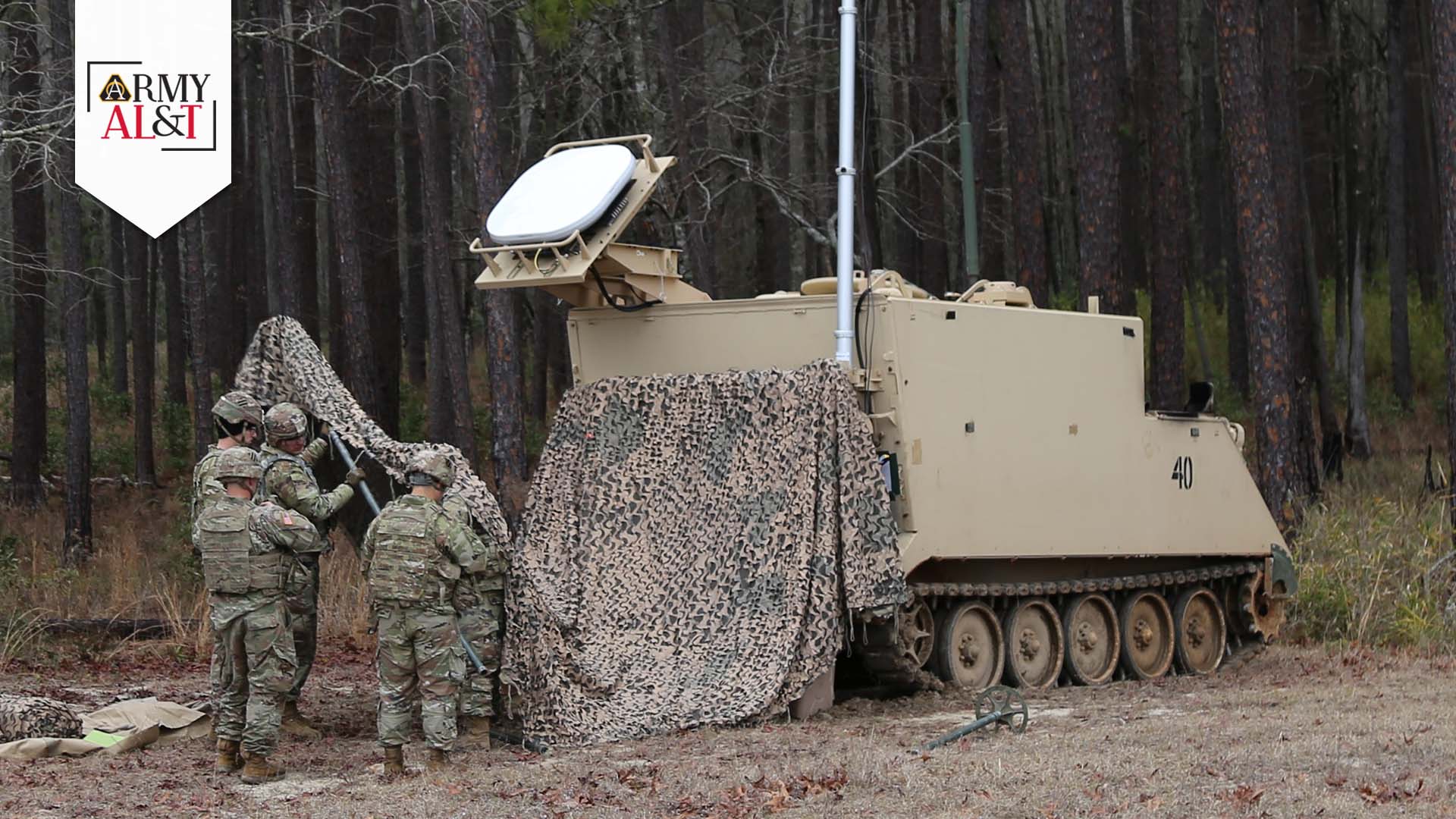
Armored Formation-on-the-Move Network Pilot informs capability set designs.
by Col. Shane Taylor, Col. Greg Napoli and Amy Walker
Recent events in Europe and around the world are highlighting the importance of the Army’s continual network modernization to ensure readiness for potential multidomain operations against near-peer adversaries. Among these priority efforts is the delivery of resilient on-the-move networking capability to armored formations. Frontline armored units combat enemy forces using a lethal combination of fire power and rapid maneuver. Improved mobile communications would greatly enhance their survivability and lethality.
To advance these efforts, the Army conducted an Armored Formation on-the-Move Network Pilot—supported by the 2nd Armored Brigade Combat Team, 3rd Infantry Division—at Fort Stewart, Georgia, in January and February. During the pilot, Soldiers evaluated new and emerging commercial network technology from more than 20 industry partners integrated onto the unit’s available surrogate M1068 armored vehicles. The intended platforms for future network integration include the Armored Multipurpose Vehicle and Joint Light Tactical Vehicle.
The pilot was not a formal operational test or review of potential solutions, but an opportunity for the Army to inform operational and technical concepts, requirements, technology maturity and affordability in support of the Capability Set 2025 (CS25) network modernization design.
Over the last several years, the Army has pivoted toward an iterative network modernization strategy that enables the service to rapidly design, acquire and field innovative capability equipment sets every two years. The capability-set process calls for open systems architectures that enable easier integration of future modernization efforts, as well as systems that are more intuitive and Soldier-centric in nature. This strategy is fueling unified network modernization across Army, joint and coalition forces. CS25, which begins fielding in fiscal year 2025, will be the Army’s first network capability set that includes armored formations.
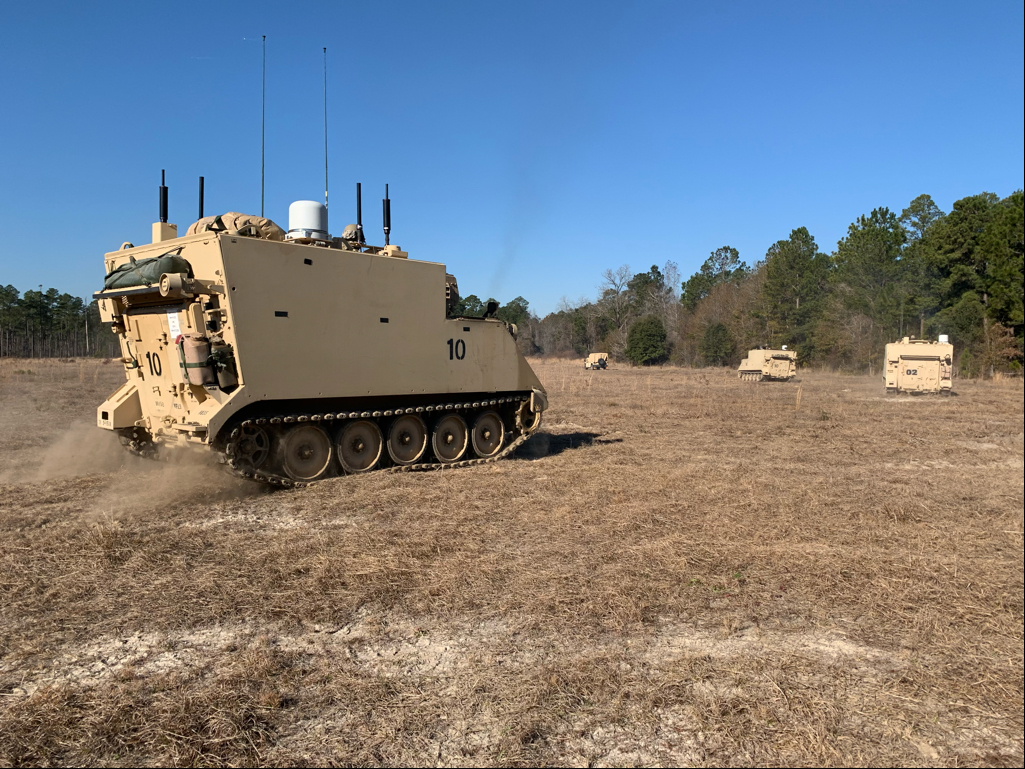
COMMUNICATIONS ON-THE-MOVE: Soldiers assigned to the 2nd Armored Brigade Combat Team, 3rd Infantry Division, conduct mission command and network communications on-the-move during the Army’s three-week Armored Formation on-the-Move Network Pilot, at Fort Stewart, Georgia, on February 2. (Photo by Capt. Detrick Moore, PEO C3T)
HALT, FIX, PIVOT
In 2018, as the Army started to withdraw from smaller scale contingency operations, such as those in Iraq and Afghanistan, senior leaders looked ahead at the potential for larger scale combat operations against more powerful adversaries and asked some key questions: What are the principal characteristics and requirements that we would need from the network to move from a forward-operating-base-centric environment and reset to large scale combat operations in a multidomain operational environment? Are we on the right modernization path to get there?
We understood that to go toe-to-toe in a great power conflict in large scale combat operations and win, we would need a new strategy that would enable us to more rapidly and continually modernize our network to retain technological overmatch. The Army’s former test-intensive, full capability acquisition strategy that was used for decades would not have enabled us to keep up with the increasing speed of technology. At the time, we had been fielding mobile network capability, known as Warfighter Information Network-Tactical Increment 2, integrated onto combat platforms for infantry units, and we were looking at how to design, test and integrate those capabilities into armored platforms. Although the requirements for mobile network connectivity for armored formations were still there, we temporarily halted our efforts to pivot to the new network modernization capability-set strategy.
A NEW PARADIGM
Through the Army’s current network modernization capability-set strategy, we are now delivering a network that addresses critical operational shortfalls and enables future multidomain operations. Instead of delivering singular stove-piped systems across the force, solutions are now part of a suite of capabilities—with open standards—and enable commanders to tailor capabilities to adapt to different operational environments and missions. These capability sets and associated technology are fielded on an iterative two-year basis that began with CS21 in fiscal year 2021. Each set builds on the previous by integrating new commercial technologies, aligning Army science and technology for transition into new programs, and leveraging Soldier-feedback and experimentation early and often in the process.
The iterative capability-set process enables us to deliver current and emerging network capabilities in a way that we don’t disrupt our ability to “fight tonight” or maintain decision dominance on the current battlefield. The intent is that we maintain readiness at the same time that we modernize our network.
CS21, the first of four currently planned capability sets, prioritized infantry formations, and was designed to provide smaller, lighter, faster and more flexible network communications. CS23 technologies are designed to increase network capacities and make them more resilient, and extends the network to Stryker formations. CS25 will build upon the previous capability sets and emphasizes network automation, resiliency and security, and will extend the network to armored formations.
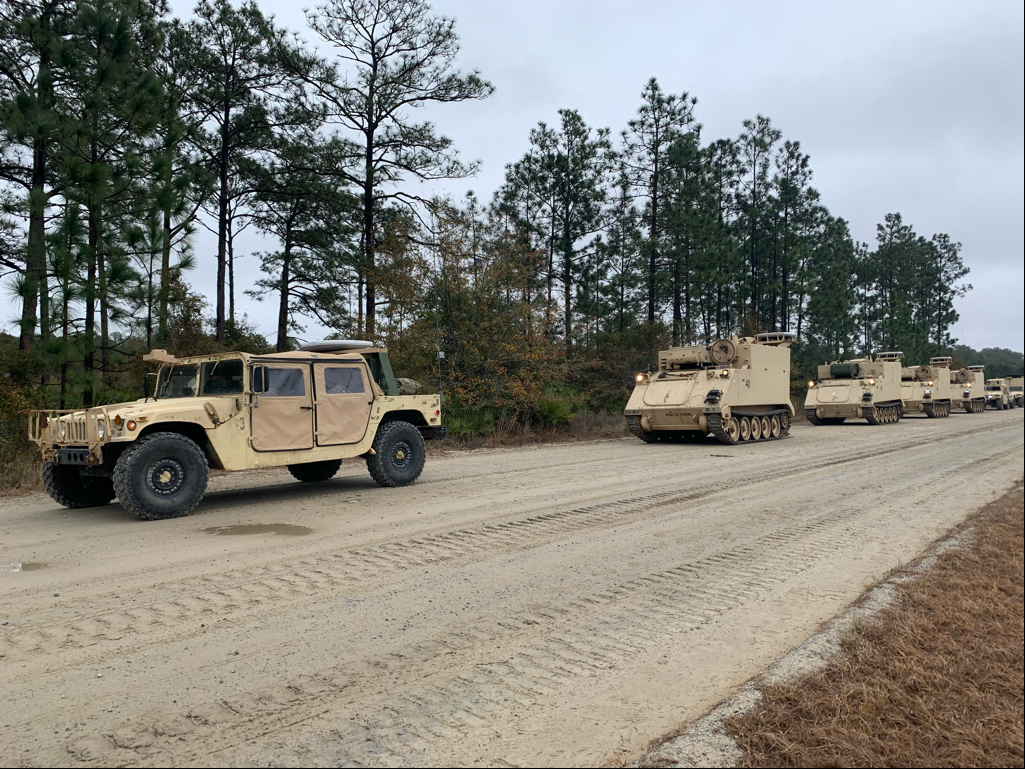
CONVOY ENABLED: The 2nd Armored Brigade Combat Team, 3rd Infantry Division, drives a convoy of satellite and line-of-sight commercial network prototypes that enable on-the-move network communications and mission command during the Army’s Armored Formation On-The-Move Network Pilot, at Fort Stewart, Georgia, on February 7. (Photo by Capt. Detrick Moore, PEO C3T)
BUILDING INTIAL REQUIREMENTS
To inform CS25 and the Armored Formation on-the-Move Pilot, we conducted Soldier surveys and site visits at the National Training Center, at Fort Irwin, California—the Army’s combat training center geared toward armored units—to garner initial Soldier feedback on armored formations and what they would need and want from a mobile network. To increase the efficiency and effectiveness of the pilot, we also leveraged lessons learned from our 2019 Expeditionary Signal Battalion-Enhanced pilot in support of CS21, which we conducted to inform a more mobile, lighter and scalable network-equipment set to modernize these signal formations.
Leveraging this Soldier feedback and lessons learned, and eventually collaborating closely with the pilot unit itself, we built on previous capability set designs to drive toward our CS25 design goals. We painted an initial picture of the network capabilities we would need to enable during the armored formation pilot. These included:
- A real-time common operational picture to enable commanders to make more timely and informed decisions.
- Reduction in fires processing times to increase lethality.
- The ability to fight dispersed and distributed. The Army understands that today’s command posts are too big and not survivable, and in future multidomain operations the Army will have to fight with units more dispersed and distributed. The final armored-formation-network equipment set will enable units and quick-halt command posts to operate decentralized and move more rapidly for improved survivability and lethality.
- Improved network resilience. A resilient network will enable robust uninterrupted world-wide data exchange, situational awareness, enhanced survivability and lethality during multidomain operations. Final equipment sets will provide more signal pathway options to enhance units’ primary, alternate, contingency and emergency (PACE) communications plans. The more signal-pathway options that exist for data to travel through, both satellite and terrestrial, the more resilient the network becomes. Network communications will be transport agnostic, enabling signals to travel over various modes of network transport, such as those leveraging other orbits, taking the optimal path of least resistance. Automatic PACE communications features will switch to a better network pathway without the user’s input.
- Easy to use. Above all, network solutions will need to be easy to use in the heat of the fight, with network complexity pulled off of the edge of the battlefield and put in the rear where experienced signal Soldiers can manage more complex tasks.
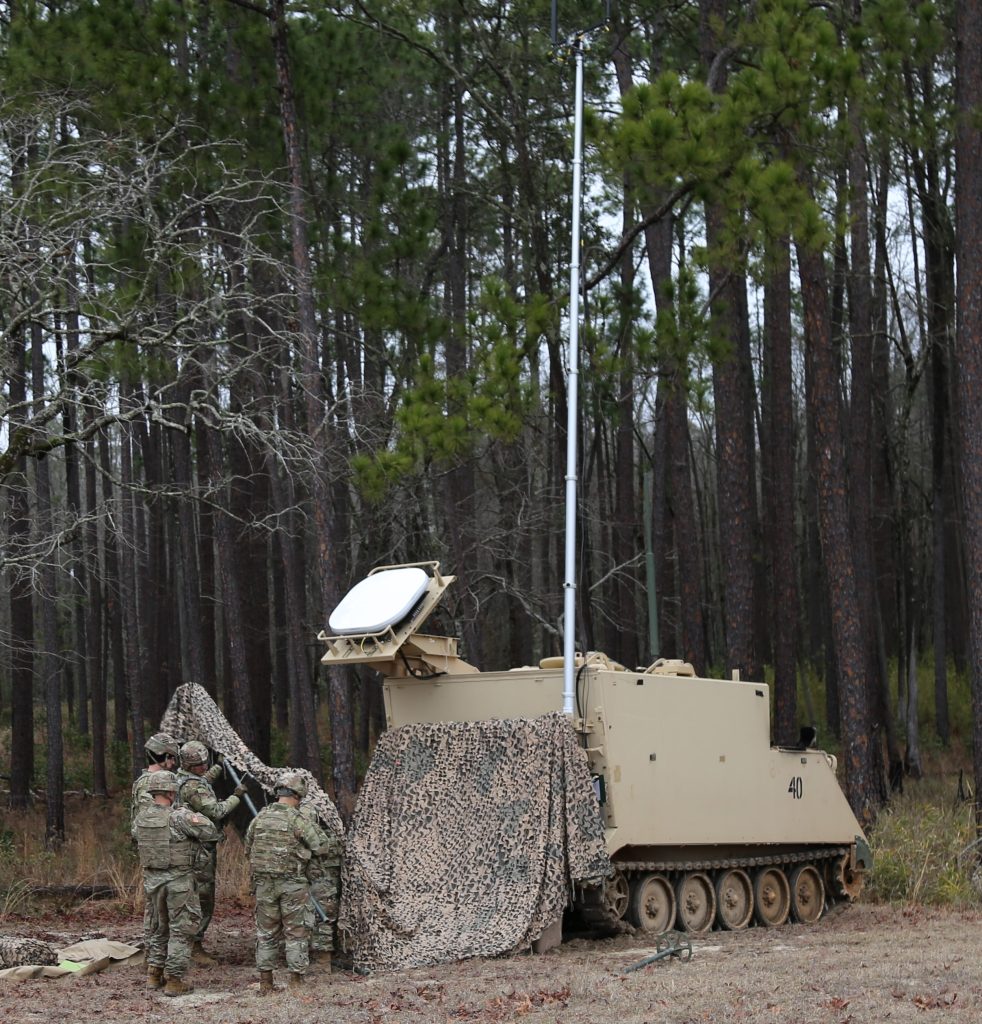
LEVERAGING LINE-OF-SITE PROTOTYPES: The 2nd Armored Brigade Combat Team, 3rd Infantry Division, leverages satellite and line-of-sight commercial network prototypes to enable on-the-move network communications and mission command, and to operate more distributed and dispersed, during the Army’s Armored Formation On-The-Move Network Pilot, at Fort Stewart, Georgia, on February 7. (Photo by Amy Walker, PEO C3T public affairs)
EARLY AND OFTEN ASSESSEMENTS
As part of the capability set process and the Armored Formation on-the-Move design development, we implemented a DevSecOps process, a term frequently used in rapid, iterativesoftware development. DevSecOps brings together the developer, the Soldier, and the requirements community early and often in the process to ensure secure Soldier-centric designs while dramatically compressing the time it takes to deliver new equipment.
As part of this process, the team conducted risk-reduction experimentation prior to the pilot, at a developmental support site at Aberdeen Proving Ground, Maryland. They also used the facility to provide a regional hub node (RHN)-like capability known as the production test node during the pilot so it wouldn’t disrupt real-world RHN missions. RHNs are large hubs that enable global connectivity to transport information both within theater and around the world.
During the pilot, the 2nd Armored Brigade Combat Team, 3rd Infantry Division stressed the network equipment during realistic brigade-driven mission threads in remote training areas at Fort Stewart. Soldiers provided user feedback on three different commercial prototype equipment sets, each with varying degrees of satellite and line-of-sight capabilities. These interoperable commercial network systems included mesh network data radios, emerging on-the-move antenna and satellite communications capabilities and small at the-quick-halt satellite communications terminals. Leveraging commercial technology allows us to keep pace with innovation and have multiple communication pathways available for our commanders.
Soldiers also provided operational feedback on how armored formations could potentially fight with these new and emerging systems on a future battlefield. In addition, we took advantage of the opportunity to cost-effectively inform additional network modernization efforts, including anti-jam capabilities, signal retransmission, expeditionary next-generation satellite transportable terminals, and QR codes affixed to systems that enabled Soldiers to pull up corresponding, real-time training materials on an issued tablet.
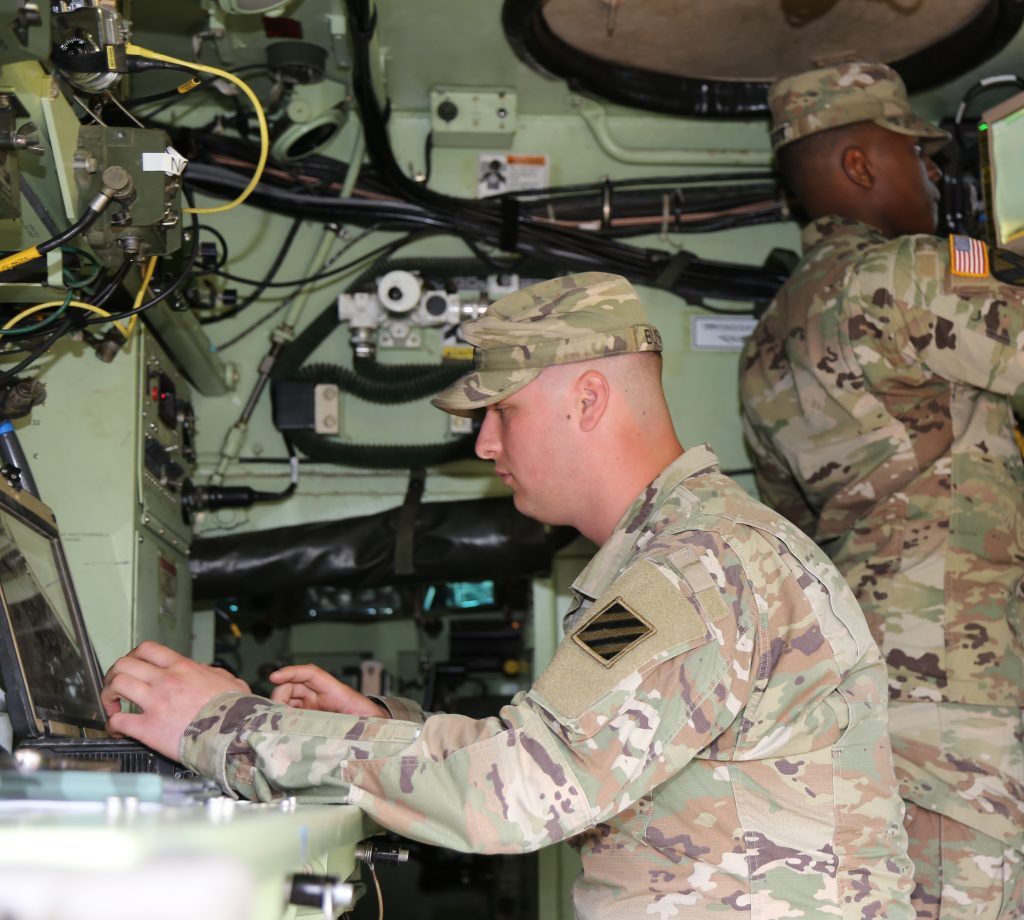
INSIDE COMMUNICATIONS: During the Army’s three-week Armored Formation On-The-Move Network Pilot, Soldiers from the 2nd Armored Brigade Combat Team, 3rd Infantry Division, communicate with the brigade headquarters from inside the network-integrated tracked vehicle at Fort Stewart, Georgia, on February 7. (Photo by Amy Walker, PEO C3T public affairs)
CONCLUSION
The Army will leverage both quantitative data derived from instrumentation integrated on the vehicle platforms and qualitative data, including Soldier feedback, to inform the CS25 armored formation on-the-move network designs. The Army Test and Evaluation Command was also on site and compiled an initial report similar to a formal traditional capabilities and limitations report. In addition to informing capability-set designs, this data will also be fed to the Army capability managers to inform future armored formation network on-the-move requirements. As we look closely at the Soldier feedback and data collected during the pilot and follow-on integration and assessment efforts, we’ll gain an even better understanding of what we will need to deliver in support of armored formation network modernization. Decisions such as equipment density, which vehicles should get what solutions, and the most affordable balance of satellite communications and line-of-sight for the equipment sets will all play a role.
The CS25 preliminary design review in April provided the initial design draft. Following additional assessments and Soldier touch-point events, the CS25 critical design review will be conducted next year and will solidify the CS25 baseline capabilities to enable fielding of initial systems. In the future, the agile and incremental capability set process will enable us to enhance that baseline if Soldier feedback warrants it or if evolving technologies become mature enough to be procured.
Solutions will be Soldier-centric, drawn from feedback of Soldiers in the field. They will increase network resiliency and the mobility, survivability and lethality of armored formations to enable successful resolution of future multidomain missions.
For more information, contact the PEO C3T Public Affairs Office at 443-395-6489 or usarmy.APG.peo-c3t.mbx.pao-peoc3t@mail.mil.
COL. SHANE TAYLOR is project manager for Tactical Network, Program Executive Office for Command, Control, Communications-Tactical (PEO C3T).He provides the direction, management and leadership for the Army’s current and future tactical communications network consisting of high-throughput line-of-sight, beyond-line-of-sight and satellite communications that enable mission command and secure reliable voice, video and data communications to Soldiers worldwide. He earned a B.S. in business administration from Oklahoma State University, an M.S. in industrial engineering and operations management from Clemson University, an MBA from Pennsylvania State University, and an M.S. in national security and resource strategy from the Eisenhower School for National Security and Resource Strategy. He is Defense Acquisition Workforce Improvement Act (DAWIA) certified advanced in program management and has foundational certification in engineering and technical management, and is a DAWIA-certified contracting professional.
COL. GREG NAPOLI is the unified network team lead at the Network Cross Functional Team, Army Futures Command. The Unified Network line of effort encompasses network transport, waveforms, and cyber security. Napoli is responsible for synchronizing requirements, resourcing, science and technology, market research, test and evaluation, and acquisition among Department of the Army stakeholders for future network capabilities. He earned M.S. in information technology management from the University of Maryland, and a M.A. in strategic studies from the United States Naval War College, Rhode Island.
AMY WALKER has been the public affairs lead at Project Manager Tactical Network for more than 10 years and was the public affairs lead at PEO C3T for the previous two. She has covered a majority of the Army’s major tactical network transport modernization efforts, including Army, joint and coalition fielding and training events worldwide. She holds a B.A. in psychology with emphasis in marketing and English from the College of New Jersey.







